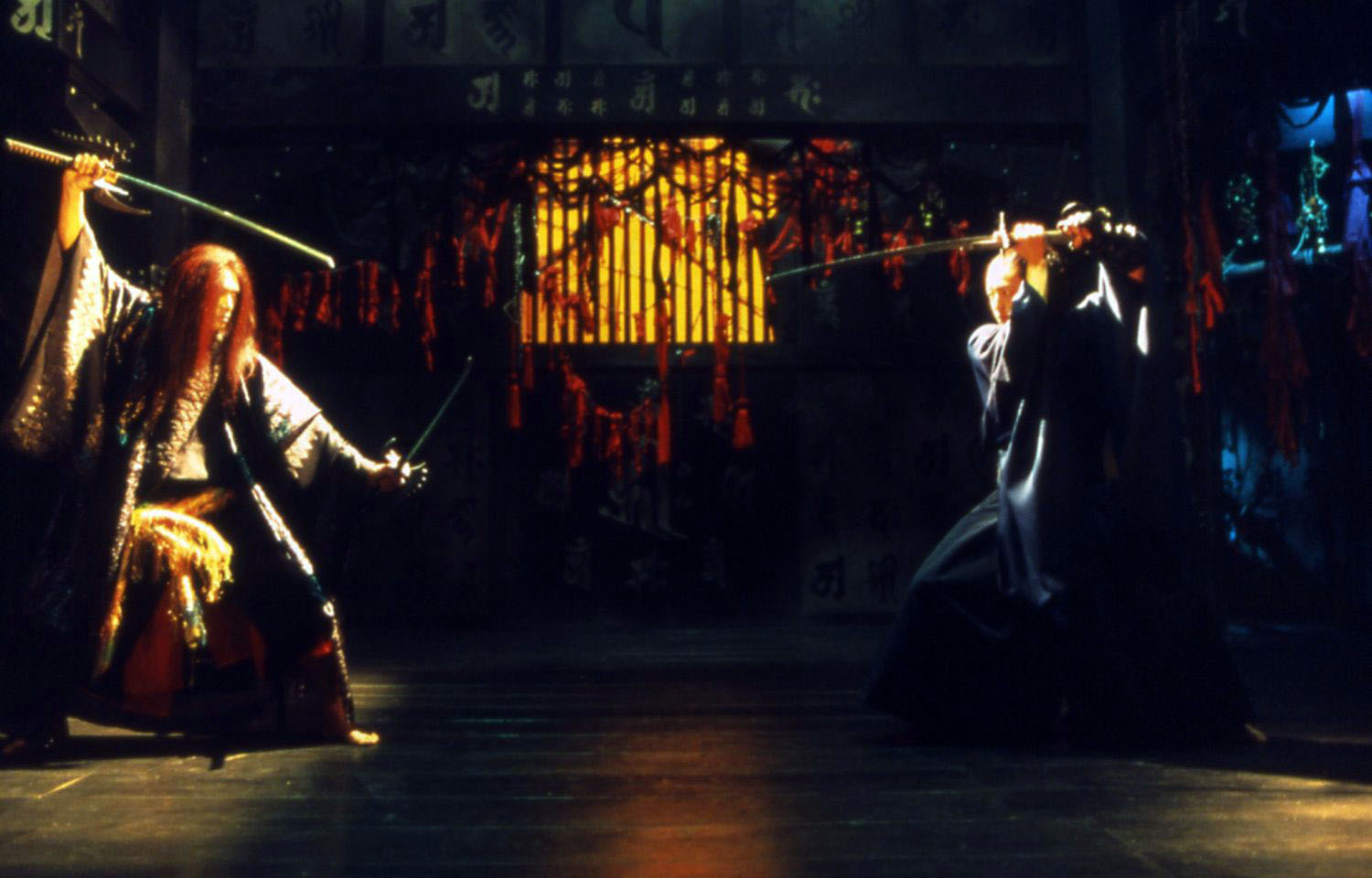Japan. 2003.
Crew
Director – Ryuhei Kitamura, Screenplay – Ryuhei Kitamura & Ryuichi Takatsu, Story – Isao Kiriyama & Shoichiro Masumoto, Producers – Yuji Ishida, Shinya Kawai & Haruo Umekawa, Photography – Takumi Furuya, Music – Nobuhiko Morino, Visual Effects Supervisor – Atsuhiko Tanaka, Special Effects Supervisor – Chuji Shimajiri, Production Design – Norifumi Ataka & Yuji Hayashida. Production Company – Napalm Films/Studio 3/Duel Partners.
Cast
Takao Osawa (Samurai), Masaya Kato (Aragami), Kanae Uotani (Woman)
Plot
A wounded samurai staggers into a mountain temple, carrying his injured comrade. The samurai comes around two days later, healed. He is welcomed and fed by the man who lives in the temple who also tells him that his comrade is dead. The samurai is invited to drink with his host. The host tells the samurai that he should not go because the mountain is inhabited by a fearsome, bloodthirsty creature – a tengu called Aragami. The man then informs the samurai that he is the Aragami. The samurai is disbelieving but the Aragami continues, telling the samurai that he believes he is the one who is destined to kill him. The Aragami also tells the samurai that he fed him the liver of his comrade in order to heal his wounds. This makes the samurai decide to take the assignment of killing the Aragami. The samurai arms himself with various weapons. However, the Aragami is an undefeated master swordsman who is immortal and able to regenerate any wound and killing him proves more difficult than the samurai anticipated.
Aragami was the third film from Japanese director Ryuhei Kitamura. Kitamura burst onto screens with the blood-drenched Yakuza/zombie film Versus (2000). He subsequently went onto other genre films such as Alice (2002), an interesting sf film about a psychological experiment conducted in a prison; a segment of the horror anthology Jam Films (2002); Sky High (2003) about a woman who returns from the afterlife as a vengeful ghost; Godzilla: Final Wars (2004); the English-language Clive Barker adaptation The Midnight Meat Train (2008); the animated science-fiction film Baton (2009), the English-language psycho film No One Lives (2012); a live-action adaptation of the manga Lupin III (2014); the English-language horror Downrange (2017) about a roadside sniper; the Mashit episode of the horror anthology Nightmare Cinema (2018); the non-genre action film The Doorman (2020) and the horror film The Price We Pay (2022), before a return to Japan with the afterlife film The Three Sisters of Tenmasou Inn (2022), as well as produced Battlefield Baseball (2003) and Hellgate (2011)..
Ryuhei Kitamura is not quite as out there as countrymen such as Takashi Miike or Shion Sono but likes to make his films in eccentric ways. Versus, for instance, used only a single exterior setting – a forest – and no constructed sets. Aragami goes one step beyond this – it is an action film that is shot in a single room, the set for the interior of a temple. Indeed, Aragami might hold some kind of record for the only action film to ever be shot using a single set. There are other similarities to Versus – both films feature immortal warriors engaged in an enigmatic battle across the ages.

Aragami starts out seeming like a giant shaggy dog story. Samurai Takao Osawa staggers into the temple with his companion, comes around and is invited to dine and enjoy a few drinks by his enigmatic host (Masaya Kato). The initial conviviality of the conversation starts to take some alarming turns as Masdaya Kato warns Osawa if he goes out he may be attacked by the Aragami and then leans in to tell him “I am that Aragami.” The conversation immediately slips back into laughter as though Osawa is not sure if he should start taking this piece of information seriously. Kato continues, casually asking the samurai how many he has killed, before answering “I have killed 764.” And then the conversation gets onto the subject of the samurai’s recovery where Kato tells Osawa that he in fact raised him from the dead – and that in order to do so he had to feed him the flesh of his companion, indeed that it was his companion’s flesh that he just ate.
There is something akin to the fascinating psychological film The Caller (1988) to these scenes – a film contained to a single location that keeps snaking around with twists and turns and constant carpet from under the feet revelations that leave you not sure if you should believe what is going on. The performances from the two lead characters are perfectly pitched.
The second half of the film branches out into an action film. Here Ryuhei Kitamura creates something oddly atemporal – the presence of a samurai suggests shogunate Japan, yet there are modern handguns among the Aragami’s weapons. The fights are expertly filmed. Kitamura employs Hong Kong-styled wirework – at one point he offers up the novelty of a swordfight that is filmed entirely in darkness lit up only by the flashing sparks from the combatant’s clashing swords. The slight disappointment is that during the second half, the initial highly captivating psychological game between two characters gives way to merely a series of swordfights.
Trailer here
Full film available here:-


